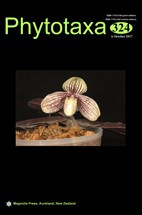Abstract
Genera in the Rhodymeniaceae Harvey that have a hollow thallus lacking diaphragms have been placed in Chrysymenia J. Agardh 1842 (including Gloiosaccion Harvey 1859), Botryocladia (J. Agardh) Kylin 1931, Irvinea Guiry in Saunders et al. 1999, and Cresia C. Lozada-Troche, D.L. Ballantine & H. Ruíz 2010. Chrysymenia has traditionally been defined by a lack of internal rhizoids and with the only solid portion of the thallus limited to the stipe. Botryocladia has been differentiated from Chrysymenia by the presence of larger, solid axes. Our results suggest that on the basis of vegetative characters alone, the true Chrysymenia clade contains specimens that exclusively produce gland cells directly on unmodified medullary cells, whereas Botryocladia and Cresia may or may not cut off gland cells from modified gland-supporting medullary cells. On the basis of comparative rbcL and SSU sequence analyses and morphological data, the hollow, gelatinous species Chrysymenia enteromorpha Harvey from the Gulf of Mexico and Caribbean Sea, and Chrysymenia wrightii Harvey described from the northwest Pacific Ocean are newly transferred to the genus Botryocladia as Botryocladia enteromorpha (Harvey) comb. nov. and B. wrightii (Harvey) comb. nov., respectively.

